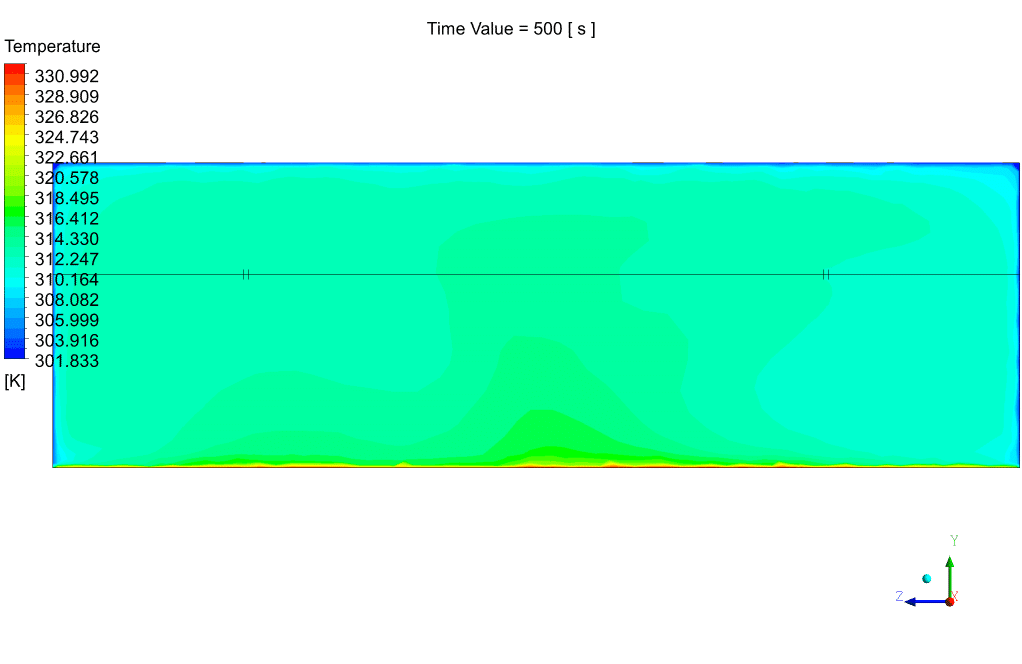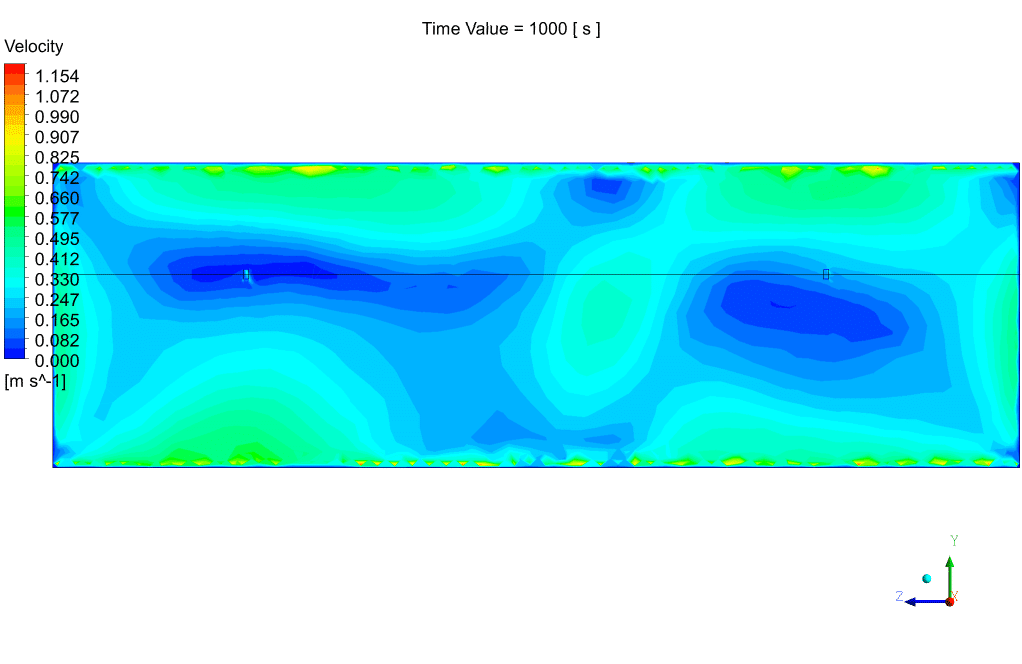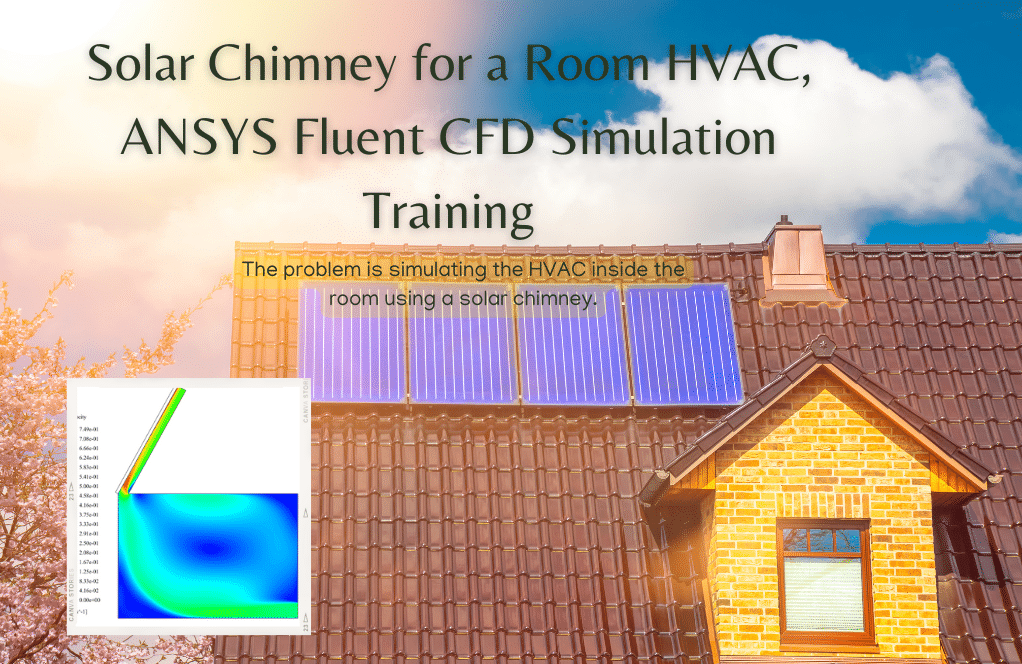Greenhouse Air Ventilation CFD Simulation Tutorial
$140.00 $70.00 Student Discount
- The problem numerically simulates the Greenhouse Air Ventilation using ANSYS Fluent software.
- We design the 3-D model by the Design Modeler software.
- We Mesh the model by ANSYS Meshing software, and the element number equals 216456.
- We perform this simulation as unsteady (Transient).
- We use the Radiation and Convection method for heat transfer.
To Order Your Project or benefit from a CFD consultation, contact our experts via email (info@mr-cfd.com), online support tab, or WhatsApp at +44 7443 197273.
There are some Free Products to check our service quality.
If you want the training video in another language instead of English, ask it via info@mr-cfd.com after you buy the product.
Description
Greenhouse Air Ventilation Ansys Fluent CFD Simulation Training
In this project, Greenhouse Air Ventilation CFD Simulation have been investigated using ANSYS Fluent software. We perform this CFD project and investigate it by CFD analysis.
The three-dimensional geometry of this project has been produced with SpaceClaim software. The length of the computational domain is 10 m, the height is 3.15 m, and the width is 4 m.
The meshing of this project has been done with ANSYS Meshing software. The element number is 216456.
Also, due to the nature of the present problem, the transient solver has been enabled.
Greenhouse Methodology
This project has been done using CFD numerical simulation method with the help of Ansys Fluent software. The air Ventilation is simulated in a greenhouse with two small fans with a radius of 5 cm that rotates at a speed of 100 rad/s.
The heat flux of 250 w/m^2 defines the lower wall of the greenhouse, and the sidewalls are defined by a coefficient of 30 and a free stream temperature of 300 K due to the thermal interaction with the outside air convection.
In this simulation, the radiation model is also activated to calculate the effects of radiation on heat and temperature transfer.
Moreover, the realizable k-epsilon model and energy equation are enabled to solve the turbulent fluid equations and calculate temperature distribution within the domain.
Also, it is set for the air density to obey the ideal gas law to change its density due to the temperature change.
Greenhouse Conclusion
At the end of the simulation, we can observe the air velocity and temperature counters. Over time, the air temperature near the greenhouse floor increases, and the density decreases due to the heat transfer from the floor, and the surrounding air has a higher density.
They replace the low air and cause heat circulation, and of course, the two existing fans also accelerate the circulation, and this cycle is repeated as well.

















Bradly Witting –
Absolutely impressive tutorial! The explanation of the greenhouse simulation is thorough, and it gave me solid insights into handling complex CFD problems. The combination of radiation and convection models sounds challenging, but the steps were simple to follow. Thank you for providing such a high-quality learning resource.
MR CFD Support –
We are delighted to hear that you found our Greenhouse Air Ventilation CFD Simulation Tutorial both insightful and easy to follow. Our goal is always to provide thorough explanations and step-by-step guides to simplify complex concepts. We appreciate your positive feedback and thank you for choosing our tutorial for your learning journey!
Steve Flatley –
I’ve used the Greenhouse Air Ventilation CFD Simulation tutorial, and the entire learning experience was truly enriching. The step-by-step process is clearly detailed, making it very easy to follow. The investigation of flow and temperature distribution around the greenhouse was particularly interesting. It extended my understanding of how CFD is applied to solve practical engineering problems. Well done on this highly educational resource!
MR CFD Support –
Thank you very much for your positive feedback on our Greenhouse Air Ventilation CFD Simulation tutorial. We’re delighted to hear that you found the step-by-step instructions clear and the content educational. It’s our goal to provide valuable resources that make complex simulations understandable and accessible. We appreciate you taking the time to let us know how our tutorial has helped you. Keep an eye on our upcoming tutorials for more practical engineering applications!
Kelly Nicolas –
I am really satisfied with the greenhouse ventilation simulation tutorial! The step-by-step guidance provided me with clear insights into setting up and solving a complex CFD problem. The instructions for simulating the fan operation were remarkably detailed.
MR CFD Support –
We truly appreciate your positive feedback on the Greenhouse Air Ventilation tutorial! Your satisfaction is our top priority, and we’re thrilled to hear that our tutorial was helpful to your understanding of CFD simulations. Thank you for your kind words!
Raymond Flatley –
The tutorial was fantastic! I appreciated learning about the effect of fan speed and positioning on air circulation pattern inside the greenhouse.
MR CFD Support –
Thank you so much for your positive feedback! We’re thrilled to hear that our tutorial on Greenhouse Air Ventilation CFD Simulation was informative and helpful. It’s great to know that the details on fan speed and placement were particularly beneficial. If you have any more questions or need further assistance, don’t hesitate to get in touch. Happy simulating!
Jess Jacobson –
I’ve heard the realizable k-epsilon model is quite effective. How did this specific turbulence model enhance the simulation for greenhouse air ventilation?
MR CFD Support –
The realizable k-epsilon model is known for its accuracy in predicting the spread of turbulent jets, which made it suitable for simulating the complex air flow patterns in the greenhouse. It helped to accurately calculate the mixing of warmer air rising from the heat source with cooler air, resulting in a more realistic representation of temperature distribution and air circulation in the greenhouse environment.
Felipa Ullrich –
How does the inclusion of the realizable k-epsilon model improve the simulation?
MR CFD Support –
The realizable k-epsilon model provides a means to more accurately simulate turbulent airflow within the greenhouse, which in turn, allows for predicting temperature distribution and airflow patterns with better precision. It accounts for the effects of turbulence intensity and length scales which are crucial in correctly determining ventilation efficiency and distribution of heat within the greenhouse.
Emilia Lynch –
I just finished going through the Greenhouse Air Ventilation CFD Simulation Tutorial from MR CFD Company, and I was mightily impressed. The meticulous detail with which the airflow and temperature distributions were explained made it easy to follow. The accompanying visuals in the tutorial helped to effectively illustrate complex concepts. Really appreciate the effort!
MR CFD Support –
Thank you for your kind words! We’re glad to hear that you found the Greenhouse Air Ventilation CFD Simulation Tutorial helpful and easy to understand. Our team works hard to create detailed and insightful training material, and it’s rewarding to know it is appreciated. Your feedback motivates us to keep producing quality educational content. Don’t hesitate to reach out if you need further assistance with your CFD learning journey!
Miss Madonna Johnson V –
This tutorial was invaluable for my understanding of climate control in agriculture settings. Does the program in this CFD course provide solutions for anomaly detection, say if a fan were to fail or airflow was blocked?
MR CFD Support –
Thank you for your complimenting our Greenhouse Air Ventilation CFD Simulation Tutorial. While the course focuses primarily on teaching airflow and temperature distribution simulations under normal operational conditions, it doesn’t specifically address anomaly detection scenarios such as fan failure or blocked airflow. Those types of scenarios would involve setting up additional simulation parameters and possibly incorporating more advanced diagnostic tools or techniques.
Donavon Hodkiewicz –
I’m thoroughly impressed with the detail provided in this tutorial. The airflow is clearly visualized, leveraging the animation feature, and the temperature changes within the greenhouse are well-replicated. I found the incorporation of the rotation of the fans and the heat flux conditions to be particularly well-done. Between the visual content and in-depth analysis, this tutorial vastly increased my understanding of greenhouse air ventilation.
MR CFD Support –
Thank you so much for your appreciative feedback! We’re glad to hear that our Greenhouse Air Ventilation CFD Simulation Tutorial provided you with a comprehensive understanding of the topic. Our team puts a lot of effort into creating detailed simulations and making sure that concepts are clearly presented and visualized. If you ever have any questions or need further validation of your learnings, don’t hesitate to reach out. Happy learning!
Miguel Mante III –
I’m looking to simulate something similar in my research. Can this software handle multiple radiation sources, and was it part of this analysis?
MR CFD Support –
Yes, ANSYS Fluent software can simulate multiple radiation sources. Although the description for the Greenhouse Air Ventilation simulation mentions only the heat flux from the lower wall, the radiation model activated in the simulation can, in fact, calculate the effects from multiple radiation sources. This feature allows for a comprehensive analysis of heat and temperature distribution within the simulated domain.
Ignacio Kohler –
I really benefited from the greenhouse air ventilation CFD simulation tutorial. The explanations on how to set up and use the fans to achieve optimal air circulation were detailed and practical. Great for anyone looking to design efficient greenhouse ventilation!
MR CFD Support –
Thank you for your kind words! We’re glad that the simulation tutorial met your expectations and provided useful insights into greenhouse ventilation design. If you need further assistance or have any more questions, please do not hesitate to ask.
Lauriane Schimmel –
I recently completed the Greenhouse Air Ventilation CFD Simulation tutorial. The step-by-step instructions were incredibly insightful. Learning how to simulate air circulation and temperature distribution in a greenhouse feels so rewarding. This has enhanced my understanding of how airflow and thermal dynamics can be optimized for agricultural applications. Great work!
MR CFD Support –
Thank you for your kind words! We’re thrilled to hear that the tutorial was helpful and enhanced your understanding of airflow and thermal dynamics in agricultural settings. Your understanding of how to use simulation to optimize environmental conditions exemplifies the value we intend to provide through our training materials. If you have any more questions or need further assistance, feel free to reach out. Happy simulating!